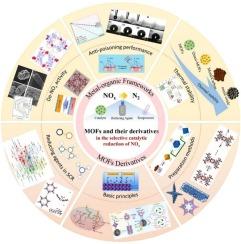mof及其衍生物在不同还原剂选择性催化还原NOx中的研究进展
IF 22
1区 材料科学
Q1 MATERIALS SCIENCE, MULTIDISCIPLINARY
引用次数: 0
摘要
选择性催化还原(selective catalytic reduction, SCR)作为一种最有效的技术,在烟气中NOx的还原中得到了广泛的应用。近年来,金属-有机骨架(MOFs)因其具有可调的金属节点和有机配体、丰富的孔隙率和比表面积、优异的化学性质和催化性能,或作为制备脱硝催化剂(如准MOFs、金属氧化物和金属/碳复合材料)的前驱体,逐渐被用作脱硝催化剂。然而,mof及其衍生物在SCR脱硝领域的应用还没有系统的报道。本文全面介绍了SCR反应的一般原理,详细介绍了以NH3、C3H6和CO为还原剂的SCR技术的发展。综述了MOF催化剂及MOF衍生物催化剂的合成方法、脱硝活性、抗中毒性能和热稳定性,重点分析了催化能力强、抗硫、抗水中毒性能优异的催化剂的催化机理。最后对mof及其衍生物脱硝催化剂的潜在发展方向进行了总结和展望,为今后mof及其衍生物在SCR领域的制备、应用和理论分析提供了见解和指导。本文章由计算机程序翻译,如有差异,请以英文原文为准。

Recent advances of MOFs and their derivatives in the selective catalytic reduction of NOx with different reductants
As one of the most effective technologies, selective catalytic reduction (SCR) has been widely utilized in the reduction of NOx in flue gas. In recent years, metal–organic frameworks (MOFs) have gradually been used as promising denitrification (de-NOx) catalysts due to their tunable metal nodes and organic ligands, abundant porosity, and specific surface area, as well as excellent chemical properties and catalytic behavior, or as precursors for the preparation of de-NOx catalysts (such as quasi-MOFs, metal oxides, and metal/carbon composites). However, there has been no systematic report on the use of MOFs and their derivatives in the field of SCR de-NOx. This review comprehensively introduces the general principles of SCR reaction, detailing the development of SCR technologies using NH3, C3H6, and CO as reductants. It summarizes the synthesis methods, de-NOx activity, anti-poisoning performance, and thermal stability of MOF catalysts and MOF-derivative catalysts, with a focus on analyzing the catalytic mechanisms of catalysts with high catalytic ability and excellent anti-sulfur and anti-water poisoning properties. At last, it summarizes and prospects the potential development directions of MOFs and MOF-derivatives de-NOx catalysts, providing insights and guidance for the preparation, application, and theoretical analysis of MOFs and their derivatives in the SCR field in the future.
求助全文
通过发布文献求助,成功后即可免费获取论文全文。
去求助
来源期刊

Materials Today
工程技术-材料科学:综合
CiteScore
36.30
自引率
1.20%
发文量
237
审稿时长
23 days
期刊介绍:
Materials Today is the leading journal in the Materials Today family, focusing on the latest and most impactful work in the materials science community. With a reputation for excellence in news and reviews, the journal has now expanded its coverage to include original research and aims to be at the forefront of the field.
We welcome comprehensive articles, short communications, and review articles from established leaders in the rapidly evolving fields of materials science and related disciplines. We strive to provide authors with rigorous peer review, fast publication, and maximum exposure for their work. While we only accept the most significant manuscripts, our speedy evaluation process ensures that there are no unnecessary publication delays.
 求助内容:
求助内容: 应助结果提醒方式:
应助结果提醒方式:


